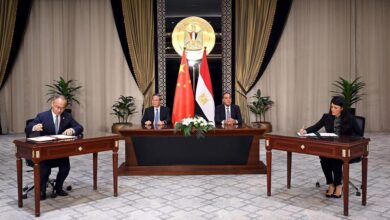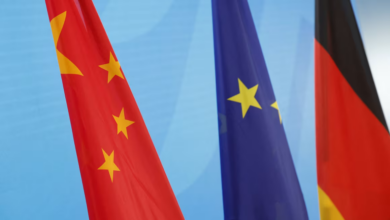A characteristic of a global hegemon is its ability to exert influence and control beyond its geographic borders and natural proximities. America’s role in the second half of the 20th century exemplifies this characteristic. A multi-site realist approach produced America's brutal domination of Central and South American politics in the 1970s and 1980s, its economic mandates over Western Europe in the post-WWII period, its stubborn foothold on Southeast Asia in the 1960s and 1970s following the Korean and Vietnam wars, and its expansion-by-proxy in the Middle East through unflinching support for Israel and corrupt dictatorships.
Since the collapse of the Soviet Union, America’s insatiable pursuit of an adversary has left it spatting and sparring with real and perceived threats expressed through a paranoid fear of its declining power in the world. Over the past ten years, US hard-talking competitiveness has resulted in periods of friction with virtually all secondary powers in the world–including Russia, India , Brazil, China, Iran, and Venezuela.
While the United States defined the direction of global politics and economics between 1990 and 2001, the gradually debilitating recession and two crippling wars in Afghanistan and Iraq seem to have overstretched its resources.
Behind the headlines, however, another superpower has risen to take America’s place as the new global hegemon. Despite its abhorrent human rights record, its notorious inability to communicate across cultural divides, its bloated bureaucracy, its muted public sphere, its insular propagandizing, its weak “public diplomacy,” and its limited appeal to the world at large, China has gone global. Today, no one in their right mind can ignore China’s competitiveness in every global economic and political sector and their firm grip on international markets.
Liu Kang, a professor of cultural studies at Pennsylvania State University and author of Globalization and Cultural Trends in China, argues that what we see as a new global China is not novel. It is the result of a longstanding policy of gaige kaifang (reform and opening up) and not necessarily exclusive to a post-revolutionary Chinese culture.
As early as 1978, the Chinese government decided to begin experimenting with models of limited capitalism in specialized economic zones that were sealed from the rest of the country and where passport-controlled customs were imposed. Each of these zones had strong international trade connections with a diasporic Chinese community, such as Taiwan or Hong Kong. John Jirik, professor of journalism and communications at Lehigh University and China specialist argues that by 1992, Chinese leader Deng Xiaoping had been impressed by these zones and decided to expand them everywhere. Jirik explains that “industries were built across the country and 18 years later, China has become the world’s factory.”
The hybrid communist-limited free market model that China is using to access global markets may be an alternative model for modernization. But nevertheless, China can continue to present itself as a “benevolent hegemon” to postcolonial nations that are wary of Western-style neoliberalism. Instead, the Chinese can utilize another discourse of “socialist anti-imperial solidarity” with countries in the Middle East, Africa, and South America.
Yet this discourse can often obfuscate the hard fact that China is no less a realist entity than the United States. University of Georgia researcher Clifton Pannell argues that one of two properties in China’s economic expansion into countries like Egypt, Iran, Sudan, South Africa and Nigeria, is the pursuit of raw materials and consumer markets for their cheap products. In countries like Ethiopia and the Sudan, Chinese incentives are evident from a symbiotic trade environment for raw materials and infrastructural returns. Yet, in Egypt, a country itself starved for natural resources, with weakening industries, miniscule reserves of raw materials, and a growing lower class, China can effectively flood the market with cheap consumer products. And it has.
Many have argued that while the complaints against dependence on the nexus of the USAID, the World Trade Organization (WTO), the International Monetary Fund (IMF), and the World Bank poses a threat to local industries, so has the Chinese alternative. In some quarters of the Egyptian market, everything from local Pharaohnic artifacts to Ramadan lanterns are being customized and manufactured in China for Egyptian vendors at a fraction of the local handicraft’s cost (this year Ramadan lanterns were fashioned after Egyptian football star Mohammed Aboutreika and coach Hassan Shehata). The dilemma for Egyptian industries, as is the case in most countries, is whether host-country manufacturing can actually compete with the tidal wave of Chinese consumer products?
So at the end of the day, China has benefited from IMF and World Bank deregulation programs in Egypt and other emerging economies worldwide, and perhaps more so than anyone else. They have essentially beat America and Western Europe at their own game. And this trend shows no sign of abating. With educated, disciplined laborers, China has at any moment close to 400 million people who are members of a cheap floating workforce. Whether they are making Ramadan lanterns for Egyptian football revelers or building a 30 mile bridge connecting Hong Kong, Zhuhai and Macao, the personnel behind China’s international trade model are adaptable and mobile. Hence the scope of China’s global influence, while seemingly invisible, is colossal to say the least.
And invisibility has been a key characteristic of Chinese success. Unlike the abrasive in-you-face jingoism of American consumerism, China is content with flying under the radar. From the easily-removable sticky tags that read “Made in China” on all products to their cultural and linguistic mimicking, this is a country content with being unbranded or counter-branded to avoid backlash. Given consumers' judgmental nature, camouflaging one’s national brand may be China’s greatest export success. Bahrain-based scholar Mohamed M. Mostafa documents this in a recently published study of animosity towards foreign products in Egypt. His structural equation model showed that consumer ethnocentrism and animosity towards the manufacturing country is a major factor in many Egyptians' decision to purchase. His study focused on the immensely unpopular Israeli products.
Chinese products, however, have a different resonance in Egypt. Some perceive their “Chineseness“ as signs of shoddily-made, short-lived, inferior and perhaps even dangerous products (such as appliances, trinkets and children’s toys) while others are seen as efficient, affordable, and lean products such as the omni-present Speranza car. Yet regardless of perception, the breadth of imports from China in Egypt will necessitate a dependency particularly in light of the dire economic conditions for the majority of Egyptians today.
A seemingly sarcastic and ironic metaphor of Egypt’s growing dependence on Chinese products, the Egyptian cheese company, Panda, uses China’s iconic endangered mammal to advertise its faux-Italian dairies. In a series of commercials that have gone viral on YouTube, a serene-looking panda stands before all those who refuse to eat his brand of cheese to the soothing background tune of Buddy Holly’s "True Love Ways". The bear punishes the offenders by erupting in fits of violence where he destroys desk computers, knocks over shopping carts, ruins a cheese-less pizza, and even unplugs a sick person’s intravenous drip. After the panda has exacted its revenge on all those who refuse the cheese, the ads close with the blatant warning “Never say no to the Panda.”
Whether seen as cute, appealing, and delicious or ominous, creepy, and insidious, Egyptians are well on their way to accepting the Panda’s hegemony.
Adel Iskandar is a media scholar and lecturer at Georgetown University. His column appears every other Thursday.




